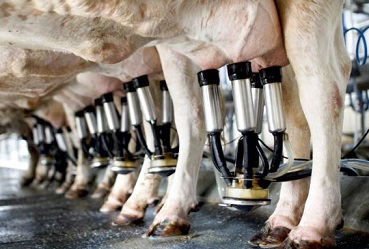Study Finds H5N1 Receptors Such As Sialic Acid (SA)-Alpha2,3 And SA-Alpha2,6 Widely Expressed In Mammary Glands Of Cows
Nikhil Prasad Fact checked by:Thailand Medical News Team May 05, 2024 11 months, 3 weeks, 8 hours, 33 minutes ago
H5N1 News: The emergence of highly pathogenic avian influenza A virus (HPIAV) in dairy cows in the United States has raised significant concerns regarding the susceptibility and potential role of cattle in the transmission and evolution of influenza viruses. Influenza A virus (IAV) is known to infect a wide range of hosts, including humans and various mammalian species. However, until recently, cattle were considered relatively resistant to IAV infection compared to other species. This paradigm shift has prompted a detailed investigation into the expression of IAV receptors in bovine tissues, particularly the mammary glands, respiratory tract, and cerebrum
 H5N1 Receptors Such As Sialic Acid (SA)-Alpha2,3 And SA-Alpha2,6
H5N1 Receptors Such As Sialic Acid (SA)-Alpha2,3 And SA-Alpha2,6
Widely Expressed In Mammary Glands Of Cows
A Danish study conducted by researchers from the University of Copenhagen-Denmark that is covered in this
H5N1 News report has found that the avian and human influenza A virus receptors sialic acid (SA)-α2,3 and SA-α2,6 are widely expressed in the mammary glands of cows.
Background and Context
Historical Resistance of Cattle to IAV: Historically, cattle have been regarded as resistant to influenza A virus infections, with susceptibility mainly limited to influenza C and D viruses. This resistance has contributed to a lack of extensive research on IAV receptors in bovine tissues.
-Emergence of H5N1 HPAIV in Dairy Cattle: The unexpected detection of highly pathogenic avian influenza virus (HPAIV) H5N1 in dairy cattle, particularly in the United States, has challenged previous assumptions about bovine susceptibility to IAV. Clinical manifestations in infected cattle primarily involve a drop in milk production and mastitis, with minimal respiratory or neurological symptoms.
-Detection of HPAIV in Bovine Milk: Recent studies have reported the presence of H5N1 virus in bovine milk samples, contradicting earlier beliefs that bovine milk could inactivate influenza viruses. These findings underscore the need for a deeper understanding of IAV pathogenesis in cattle.
IAV Receptors in Bovine Tissues: A Detailed Analysis
-Expression in Mammary Glands:
The study reveals widespread expression of human and duck IAV receptors in the mammary glands of cows, particularly in alveolar cells.
Interestingly, the chicken receptor was not detected in mammary gland tissues, suggesting a differential receptor distribution in bovine organs.
-Distribution in Respiratory Tract:
In the respiratory tract, all three IAV receptors were observed in varying abundances across different regions.
The upper respiratory tract exhibited expression of the chicken receptor, while the lung alveolar cells expressed all thr
ee receptors, resembling patterns seen in pigs and humans.
-Evaluation in Cerebrum:
Minimal to no expression of IAV receptors was found in the cerebrum of cattle, which may explain the absence of neurological symptoms in HPAIV-infected cows.
Interpretation and Implications
-Significance of Mammary Gland Receptors:
Co-expression of human and avian IAV receptors in mammary glands indicates potential susceptibility to both human/swine and avian-origin viruses.
The high viral load observed in bovine milk samples aligns with the receptor distribution in mammary tissues, highlighting the importance of local viral replication
-Transmission Routes and Pathogenesis:
The study discusses possible routes of viral entry into mammary glands, considering both ascending infection and systemic dissemination via the blood supply.
The role of viremia in facilitating mammary gland infection is explored, although the extent of viremia in HPAIV-infected cows remains uncertain.
-Comparison with Other Species:
Variations in IAV receptor expression between bovine and other mammalian species underscore the unique host-pathogen interactions in cattle.
The absence of significant receptor expression in the cerebrum correlates with the lack of neurological symptoms, suggesting a tissue-specific response to HPAIV infection.
Future Directions
Future research directions should focus on:
-Further elucidating the mechanisms of viral entry and replication in bovine tissues.
-Investigating the epidemiological impact of IAV infections in cattle and their potential contribution to viral evolution.
-Assessing strategies for mitigating the risk of zoonotic transmission from infected cattle populations.
Conclusion
The study sheds light on previously unexplored aspects of influenza A virus receptor distribution in cattle. The findings indicate a potential susceptibility of cows to a wide range of IAV strains, including those of avian origin. This raises concerns about the zoonotic potential and the role of cattle as a possible reservoir or mixing vessel for novel influenza viruses.
In conclusion, a comprehensive understanding of IAV receptors in cattle is crucial for developing effective surveillance, prevention, and control measures against emerging influenza threats in both animal and human populations.
The study findings were published on a preprint server and are currently being peer reviewed.
https://www.biorxiv.org/content/10.1101/2024.05.03.592326v1
For the latest
H5N1 News, keep on logging to Thailand Medical News
